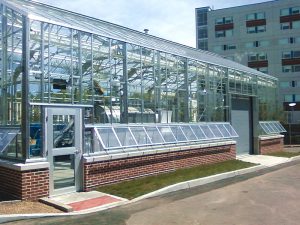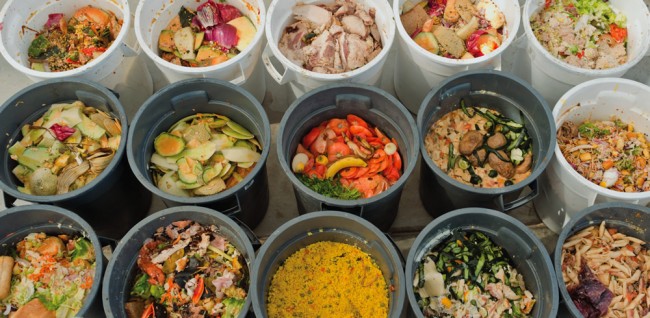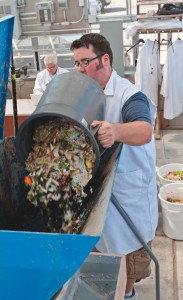Kean University in New Jersey installed a rotary drum composter to process pre and postconsumer food waste from campus dining facilities.
BioCycle January 2013, Vol. 54, No. 1, p. 33
Nora Goldstein
The composting facility is located in a 1,000 square foot greenhouse named the Food Scraps Composting Laboratory. Kean University President Dawood Farahi approved appropriation of the entire cost of the project; however, Smith-Sebasto received about $25,000 in grant funds from the New Jersey Department of Environmental Protection to support the project. The system, designed by FOR Solutions, LLC and manufactured by a local fabrication company, cost approximately $80,000. Cost of the greenhouse was about $400,000. “From the outset, the idea was to create a laboratory in which research on using the compost as a soil amendment could be conducted,” notes Smith-Sebasto. “A greenhouse seemed the logical solution. And President Farahi treats the composting system as a positive feature of the campus and wanted it to be visible.”
All food scraps, including proteins, fruits, vegetables, breads, grains and bones, are collected from the dining areas in 10-gallon buckets with lids. Most of the food service areas are within 100 yards of the Food Scraps Composting Laboratory, so the majority of filled buckets are transported from the dining facilities in a wheeled cart. (One dining hall needs to be serviced with a vehicle.) Five-gallon buckets are used to collect scraps from the Starbucks on campus. In all but one of the dining facilities, plates are scraped by food service workers employed by Gourmet Dining, the contracted food service provider on campus. Gourmet employees also collect prep scraps in 10-gallon buckets.
There is very little soiled paper mixed in, and just a small amount of compostable products as those are only used in the food court and the Starbucks. After weighing thousands of buckets, Smith-Sebasto and student assistants have determined that the average weight of a 10-gallon bucket full of a very heterogeneous mixture of food scraps is 35 lbs. The average weight of a 5-gallon bucket is 19 lbs. Both are of a weight that an average person is able to lift, Smith-Sebasto says.
Composting Operation
Food scraps are added to the composting drum daily on weekdays. The composting system is capable of processing 1,000 lbs/day of food scraps. This amount was identified during an audit performed during the summer of 2009. To achieve the desired C:N ratio, 25 lbs of wood shavings are added to every 100 lbs of food scraps. Buckets of food scraps are emptied into a hopper that feeds a shredder, which reduces their volume by about 30 percent. “This increases the surface area, which aids in the biological digestion,” notes Smith-Sebasto. “All food scraps are reduced to roughly the size of a sugar cube.” Shredded food scraps drop into an enclosed screw auger that conveys them to the composting vessel. Wood shavings are also conveyed by the auger but via a separate input that bypasses the shredder. “There is no need to further shred the wood shavings because they are of an acceptable size,” he adds.
The off-loaded compost, about one cubic yard per processing day, is used on campus in a variety of landscaping projects and on the 6-acre farm that grows food for the university’s upscale, farm-to-table restaurant named Ursino, as well as the other dining areas. It is not composted further prior to use. “The C:N ratio has been found to be in the 10-15:1 range,” explains Smith-Sebasto. “Solvita values have been in the 2 to 4 range. My research is looking at the importance of high microbial activity and nutrient transport in food scraps compost. What I am finding is that so-called unstable or immature compost appears to provide very effective nutrient transport and positive plant response.”
Peter Turso, Executive Chef at Ursino, has observed “vigorous and aggressive growth” in plants grown in plots and containers enriched with the food scraps compost. “The fruits and vegetables cultivated with it have a marked difference in final yield weight and overall juiciness and flavor.” Jeff Eckert, Supervisor of Buildings and Grounds at Kean’s Liberty Hall Museum, also has had good results with the compost: “I have been using the compost in all aspects of groundskeeping at Liberty Hall Museum. We have noticed hardier blooms on our roses as well as our perennials and annuals. Lawn areas where we have incorporated the compost exhibit a noticeably darker green color even through drought type conditions. The compost’s moisture retention ability has also significantly reduced our watering requirements.”
In the nearly 300 days that the project has been in operation, roughly 250,000 lbs of food scraps have been processed with about 60,000 lbs of wood shavings to produce about 200 cubic yards of compost. Using the U.S. E.P.A. WARM model calculator, in 2012 the project was responsible for 13.5 MTCO2E emissions avoidance and 38 million BTUs of energy saved, according to Smith-Sebasto.













